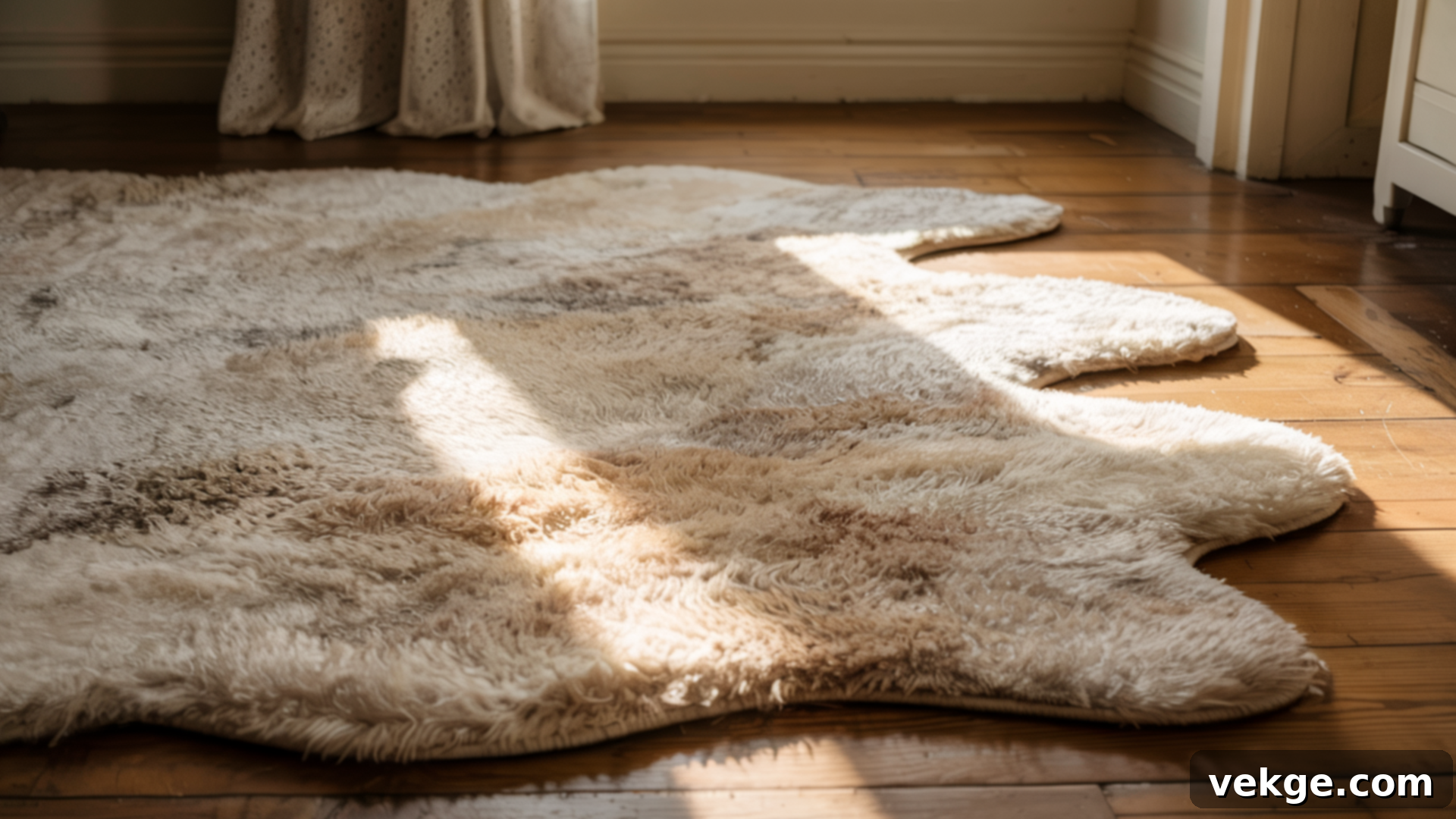How to Flatten a New Rug: Expert Tips to Eliminate Curls, Bumps & Wrinkles
Bringing a beautiful new rug into your home can instantly transform a space, adding warmth, texture, and style. However, the excitement often fades when you unroll your new acquisition only to find it’s covered in stubborn bumps, ripples, or curled edges. This common annoyance, often referred to as “rug memory,” can make your otherwise perfect rug look less than ideal and even pose a tripping hazard. We completely understand the frustration when all you desire is a smooth, flat rug right out of the packaging.
Good news! You don’t have to live with a lumpy rug. This comprehensive guide is designed to empower you with simple, yet highly effective methods to flatten any new rug with ease. We’ll walk you through a variety of proven techniques, from basic household tricks to specialized rug care tips, ensuring your rug lays perfectly flat and looks its best in no time. Whether you’re dealing with a tightly rolled area rug or a runner with persistent waves, we’ve got you covered. Ready to transform your new rug from lumpy to luxurious? Let’s dive in and make those unsightly creases disappear!
Why Do New Rugs Curl and Wrinkle? Unraveling the Mystery of “Rug Memory”
It’s a common scenario: you unroll your new rug, expect it to lie perfectly flat, but instead, it stubbornly retains its rolled-up shape. This phenomenon isn’t a flaw; it’s usually a result of several factors related to manufacturing, shipping, and the rug’s inherent characteristics. Understanding these causes is the first step toward effectively flattening your rug.
One of the primary culprits is “rug memory.” During the manufacturing and shipping process, rugs are typically rolled or folded tightly for extended periods. This continuous pressure and confinement cause the fibers and backing to conform to that shape. When unrolled, the rug’s material retains a “memory” of its compressed state, leading to persistent curls, ripples, and creases. New rugs often require a period of adjustment to relax and adapt to their new environment and flat surface.
The rug’s material also plays a significant role. Natural fibers like wool, jute, and cotton can be more prone to curling and creasing due to their inherent elasticity and tendency to absorb moisture. Synthetic fibers such as polypropylene or polyester, while often more resilient, can also develop strong memory if stored improperly. The stiffness of the rug’s backing is another key factor; a very rigid backing may resist flattening, while a more flexible one might develop waves more easily over time.
Environmental conditions further influence a rug’s ability to flatten. Humidity and temperature changes can affect fiber expansion and contraction, exacerbating curling or creasing. For instance, a rug unrolled in a cold room might remain stiff longer than one in a warmer environment. Moreover, an uneven or excessively slippery floor surface can prevent the rug from settling properly, contributing to its tendency to buckle or slide.
The Hidden Impact of Rug Backing and Storage on Flatness
Beyond the rug’s face fibers, the type and thickness of its backing material significantly influence how well it lies flat. Different backings react uniquely to rolling, folding, and environmental conditions, making some rugs more challenging to flatten than others.
Rugs with rubber or latex backings are particularly prone to curling at the edges, especially in high-traffic areas like entryways. The stiffness of these materials, combined with repeated pressure from foot traffic or even opening doors, can cause the corners to flip up persistently. Over time, these backings can also become brittle, making them even less flexible. On the other hand, rugs featuring soft felt backings tend to develop waves or buckles across their surface rather than sharp edge curls. While felt offers cushioning, it can lack the structural integrity to prevent undulations when the rug is shifted or walked on frequently.
Storage conditions are equally crucial. If your rug has been stored for a prolonged period, especially if it was rolled too tightly, folded haphazardly, or kept in cold, damp conditions, it is likely to have developed stubborn creases that are much harder to remove. Rugs unrolled in cold rooms, particularly during winter months, can remain stiff and unyielding for a longer duration because the cold makes the fibers and backing less pliable. Conversely, warmth and sufficient time are often the most crucial factors in flattening a new rug. Allowing the rug to acclimate in a warm environment helps the fibers relax and the “rug memory” to gradually dissipate, letting those unsightly lines and curves soften and disappear.
Proven Methods to Successfully Flatten Your New Rug
Don’t let a bumpy rug diminish the aesthetic of your home. There are several simple, yet highly effective methods you can employ to encourage your new rug to lay perfectly flat. Here are our top techniques to tackle those persistent creases and curls:
1. The Power of Reverse Rolling
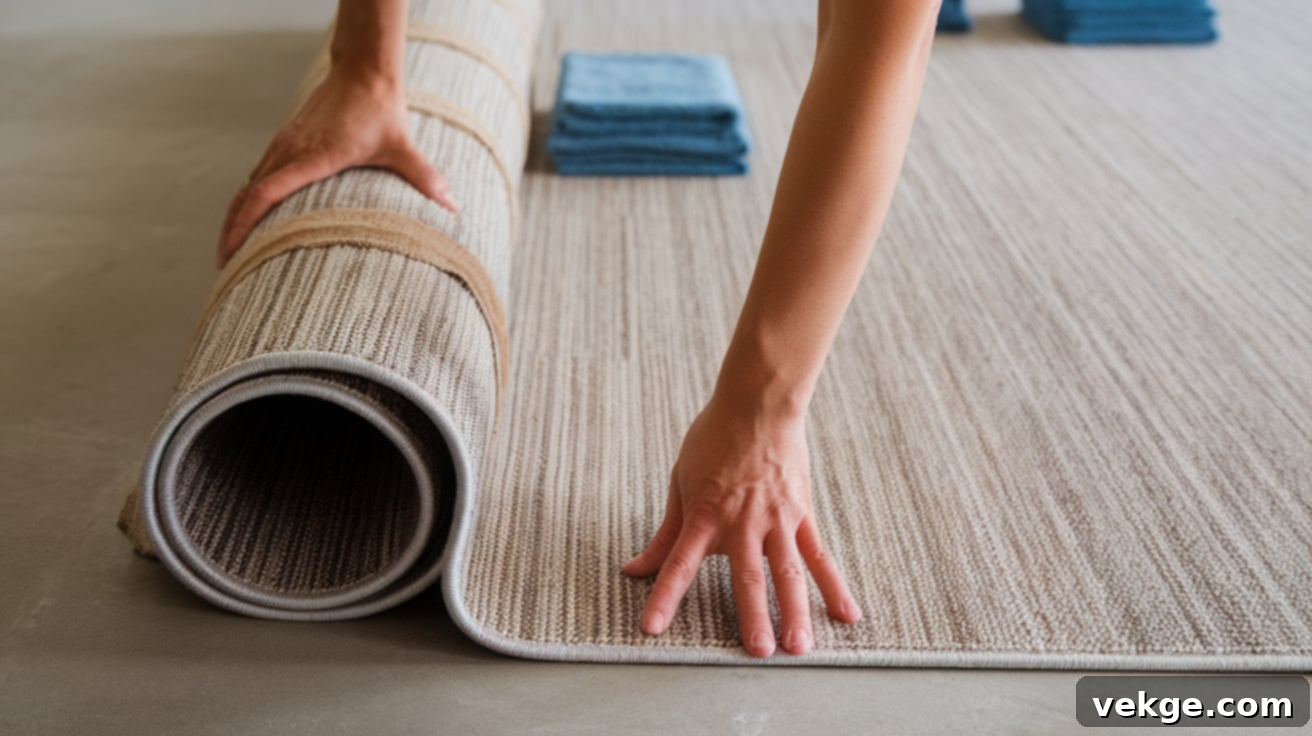
For rugs that have developed a strong curl from being rolled in one direction for too long, the reverse roll method is often the first and most effective solution. The concept is simple: you’re training the rug to uncurl by gently bending it in the opposite direction. Start by turning the rug upside down, so the backing faces up. Then, tightly roll the rug in the opposite direction from how it was originally packaged. Once rolled, secure it firmly with masking tape, bungee cords, or straps to maintain the new, reversed shape. Allow it to remain in this state for several hours, or ideally, overnight. This counter-pressure helps to relax the fibers and backing, encouraging the rug to lay flat when unrolled again. This technique is particularly effective for thinner to medium-thickness rugs and those made from synthetic or natural fibers that aren’t overly stiff. However, exercise caution with very thick or stiff rugs, as forcing them might damage the backing or fibers.
2. Harnessing the Weight of Everyday Objects
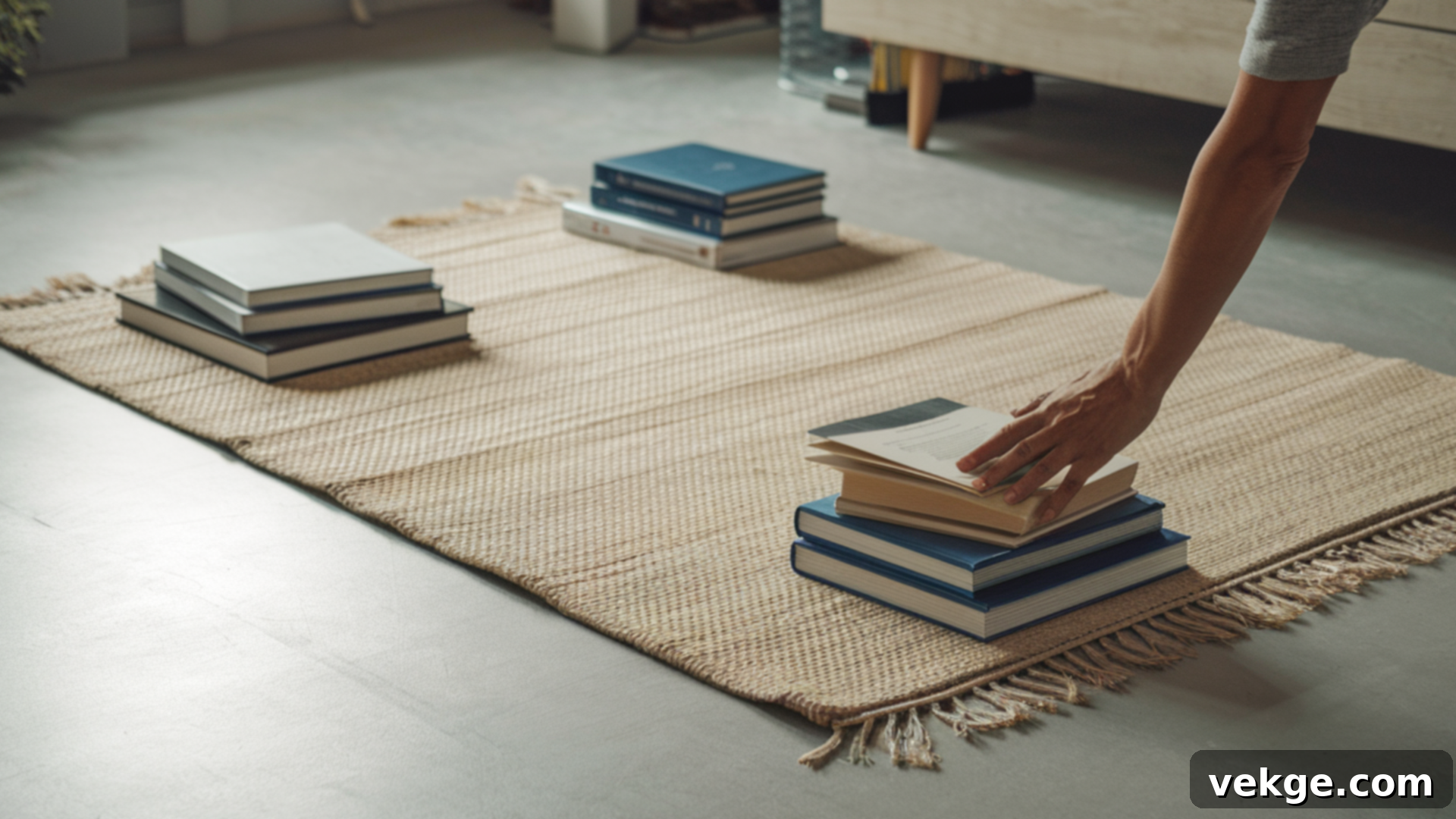
One of the most straightforward and universally applicable methods to flatten a rug is by applying consistent, heavy pressure. After unrolling your rug and laying it flat, identify any curled edges, stubborn ripples, or persistent bumps. Then, place heavy, flat-bottomed items directly onto these problem areas. Excellent choices include stacks of large books, heavy furniture (like sofas or tables), dumbbells, or even storage boxes filled with household items. Ensure that whatever you use is clean and dry to prevent any stains or marks on your rug. Leave these weights in place for at least 24 to 48 hours. This sustained pressure helps to compress the fibers and backing, forcing the rug to conform to the floor. This method works exceptionally well for area rugs, runners, and rugs with light to moderate curling. For best results, gradually increase the weight or redistribute it over time if the rug still isn’t completely flat.
3. Gentle Heat Application: Hair Dryers, Steam Irons, and Sunlight
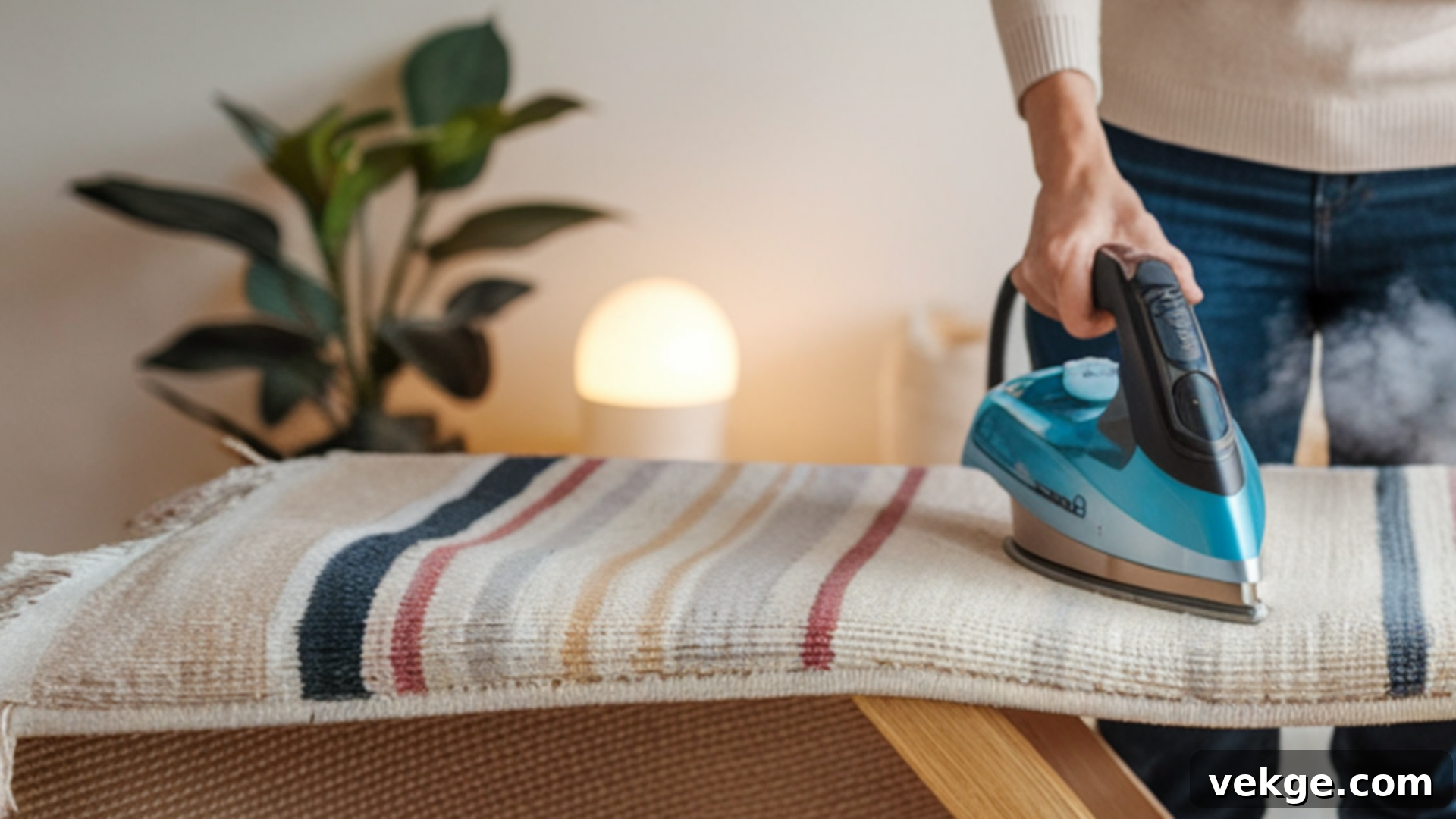
A controlled application of gentle heat can work wonders by making rug fibers more pliable and encouraging them to relax into a flat position. You can utilize a hair dryer, a steam iron (on a low setting), or a clothes steamer. When using a heat tool, always place a damp towel or cloth over the wrinkled or curled section of the rug first. This barrier protects the rug fibers from direct heat damage and introduces a small amount of moisture to aid in relaxation. Hold your heat tool a few inches above the damp towel and move it in slow, circular motions, ensuring even heat distribution. The warmth and slight moisture will help the rug fibers loosen and settle. This technique is particularly effective for synthetic rugs or blends, as these fibers respond well to heat. However, it’s crucial to avoid using direct, high heat on delicate natural fibers like wool, silk, or jute, as it can cause irreversible damage, shrinking, or discoloration. Always test a small, inconspicuous area of the rug first to ensure it can safely handle the heat without adverse effects.
4. The Clever Ice Cube Trick for Stubborn Corners
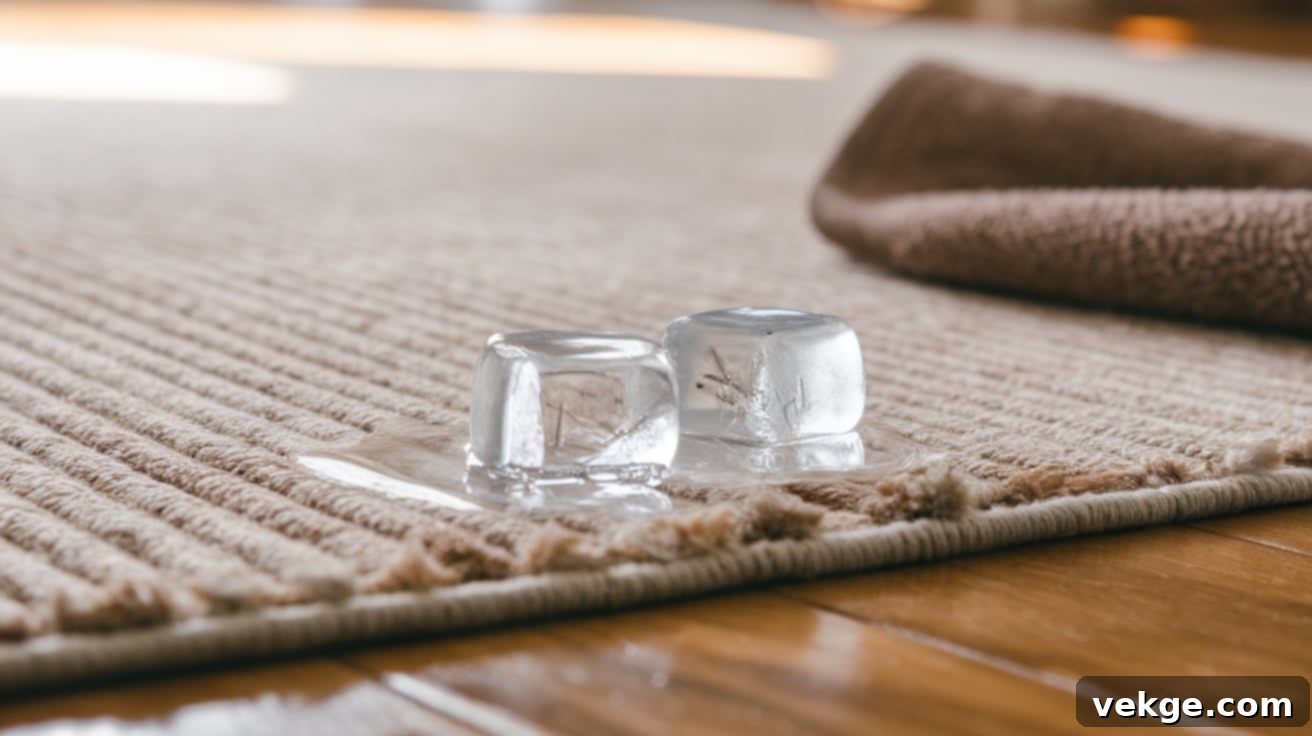
For those incredibly stiff, unyielding corners that simply refuse to stay down, the ice cube method can be a surprisingly effective solution. This technique leverages the gentle, gradual softening power of melting ice. Place a few ice cubes directly onto the curled or creased edge of the rug. Allow the ice cubes to melt naturally, letting the water slowly soak into the rug fibers. As the cold water gradually penetrates, it softens and relaxes the synthetic fibers, encouraging them to flatten. Once the ice has completely melted, gently blot the area with a clean, dry towel to absorb excess moisture. Then, press down firmly on the softened spot to help flatten it into place. This trick works particularly well on synthetic rugs or blends with hard corners. However, it’s vital to avoid using this method on natural fiber rugs such as jute, sisal, or wool, as these materials can absorb too much water, leading to potential damage, discoloration, mildew growth, or permanent distortion of their shape.
5. Secure Your Rug with Tape or Grippers
If your rug continues to slide, bunch up, or if its corners persistently pop up despite other flattening efforts, rug tape or specialized corner grippers can provide a lasting solution. These products are designed to create a strong, temporary bond between the rug and the floor, keeping it firmly in place. To use, simply apply the rug tape or grippers to the back of the carpet, particularly along the edges and corners. Once applied, press the rug firmly onto the floor, ensuring good contact between the adhesive and the surface. This not only prevents the rug from shifting but also helps to hold down any curling edges, encouraging them to flatten over time. Rug tape and grippers are excellent options for lighter rugs that are prone to movement or for areas with high foot traffic. Before applying any adhesive product, always test it on a small, hidden area of your flooring to ensure it won’t leave residue, marks, or cause any damage upon removal. Choose products specifically labeled as “floor-safe” or “residue-free.”
6. Patience is a Virtue: Letting Your Rug Naturally Settle
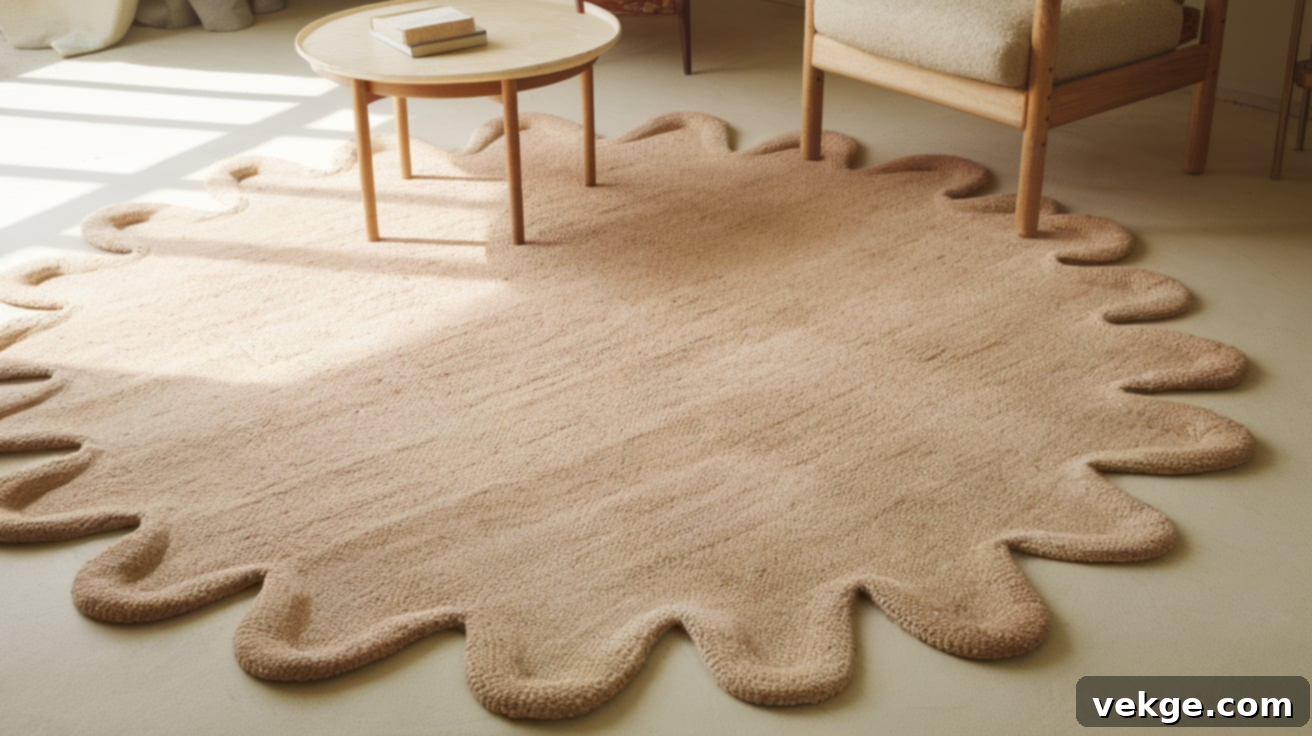
Sometimes, the simplest and most overlooked solution is also the most effective: just give your rug time to breathe and settle. After unrolling a new rug, especially if it doesn’t have extremely strong curls or deep creases, simply laying it flat in a warm room with minimal foot traffic can allow gravity and ambient conditions to do their work. Over a few days, or sometimes a week, most rugs will naturally relax and gradually settle into their flat position. This method is ideal for new rugs with mild “rug memory” or those that are only slightly wavy. To facilitate this process, ensure the room is warm enough to allow the fibers to relax, and keep children and pets off the rug during this initial settling period to prevent new bumps or folds from forming. All it truly requires is a little patience and some open floor space to allow your rug to adapt to its new home.
7. The Foundation of Flatness: Using a Quality Rug Pad
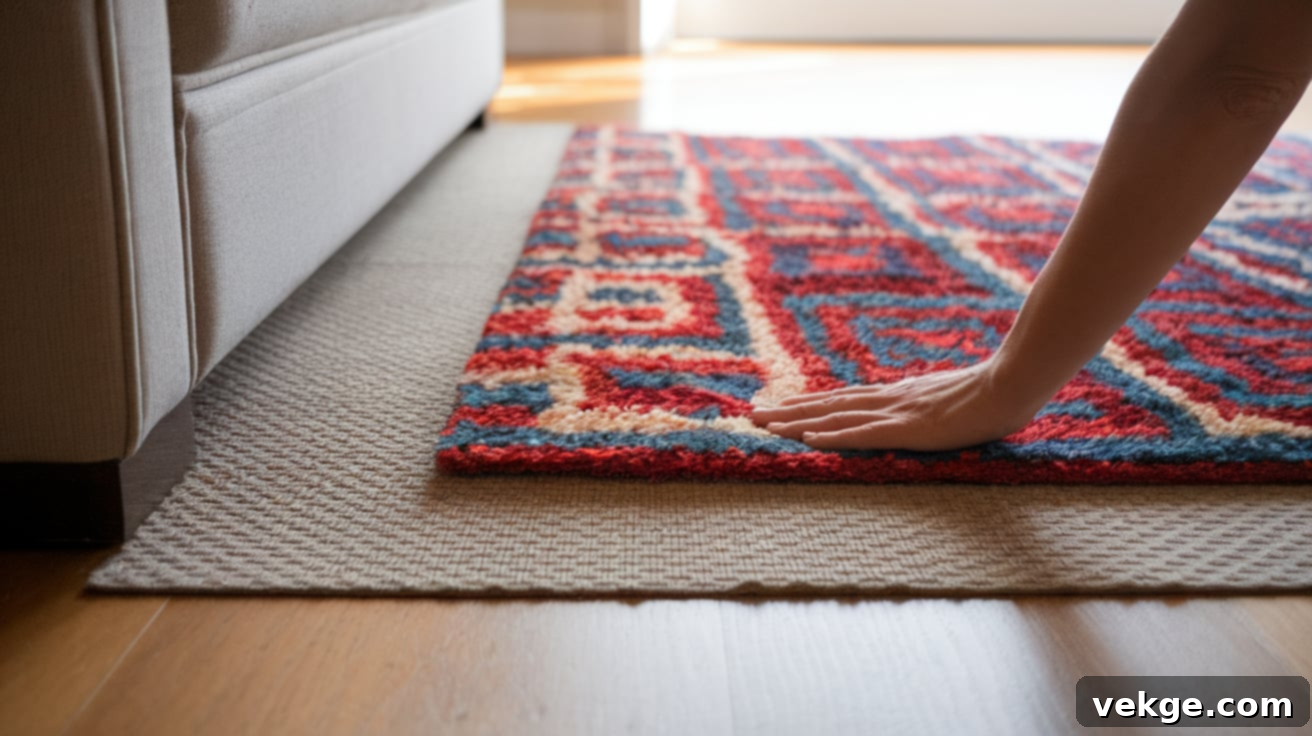
A high-quality rug pad is not just for preventing slips; it’s a foundational tool for ensuring your rug lays flat and stays that way. A good rug pad provides consistent grip and steady support across the entire underside of your rug, which actively helps to counteract the tendency of edges to curl over time. By creating a stable layer between the rug and the floor, a pad prevents the carpet from sliding, bunching up, and developing new wrinkles, especially on smooth surfaces like wood, tile, or laminate. For thicker rugs, a felt rug pad offers excellent support, adds cushioning, and helps maintain the rug’s shape. For thinner rugs or floors where maximum grip is needed, a rubber or mesh pad is ideal for preventing movement. Investing in the right rug pad is a smart, long-term fix that not only keeps your rug flat but also makes it safer, extends its lifespan by reducing wear, and enhances comfort underfoot.
8. The “Flip It” Technique: Turning the Rug Upside Down
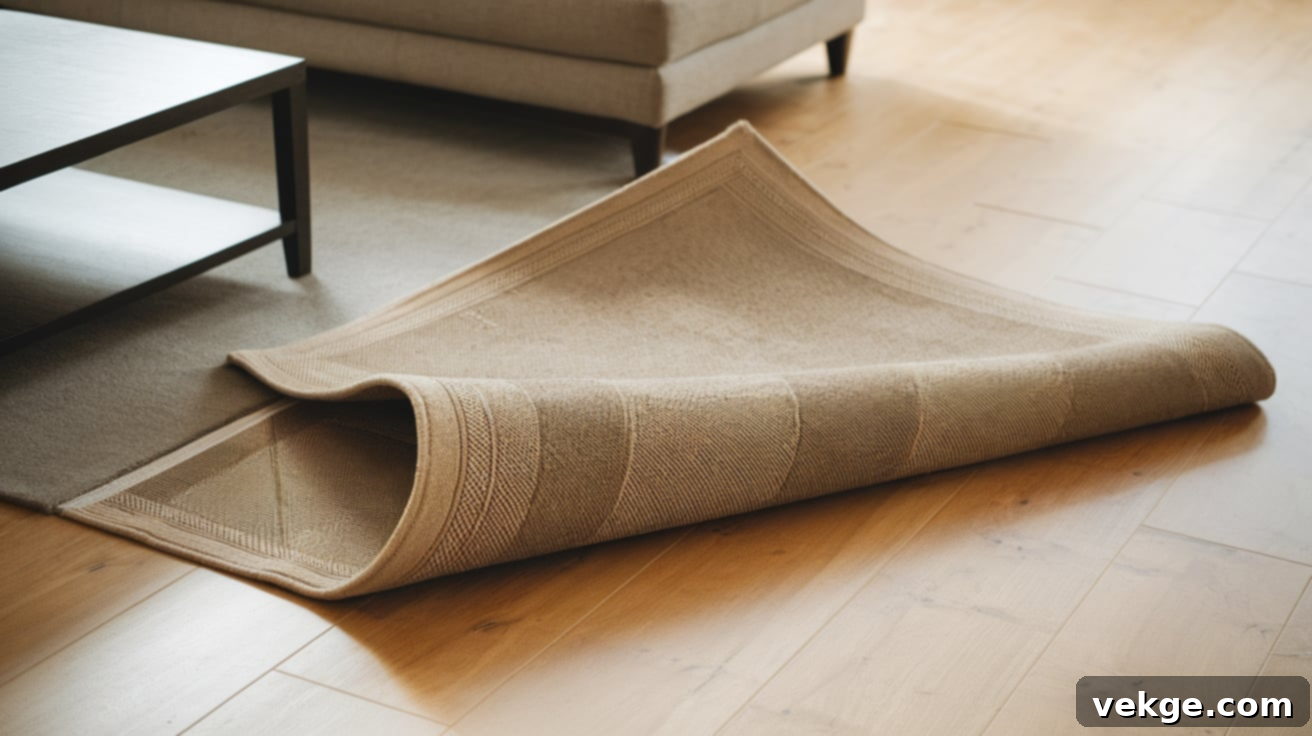
Similar to the reverse rolling method but even simpler, flipping your rug upside down can be an effective way to encourage it to flatten. By laying the rug face-down on a flat surface, such as the floor, you allow the fibers to relax in the opposite direction of their initial curl. This creates counter-tension that helps to smooth out bumps and wrinkles. Leave the rug in this position for a few hours or even overnight. To accelerate the process, you can place a few heavy books on the specific areas that are still problematic or gently lay a warm, damp towel on top (making sure it doesn’t get the actual rug too wet if it’s a delicate material). The combined weight and mild heat (if using a towel) will gently press the rug down and encourage it to release its memory. This is a particularly easy and safe fix that works well for new rugs with light to medium curling or soft waves, requiring no special tools or significant effort.
9. Temporary Corner Folding: A Quick Fix for Pop-Up Edges
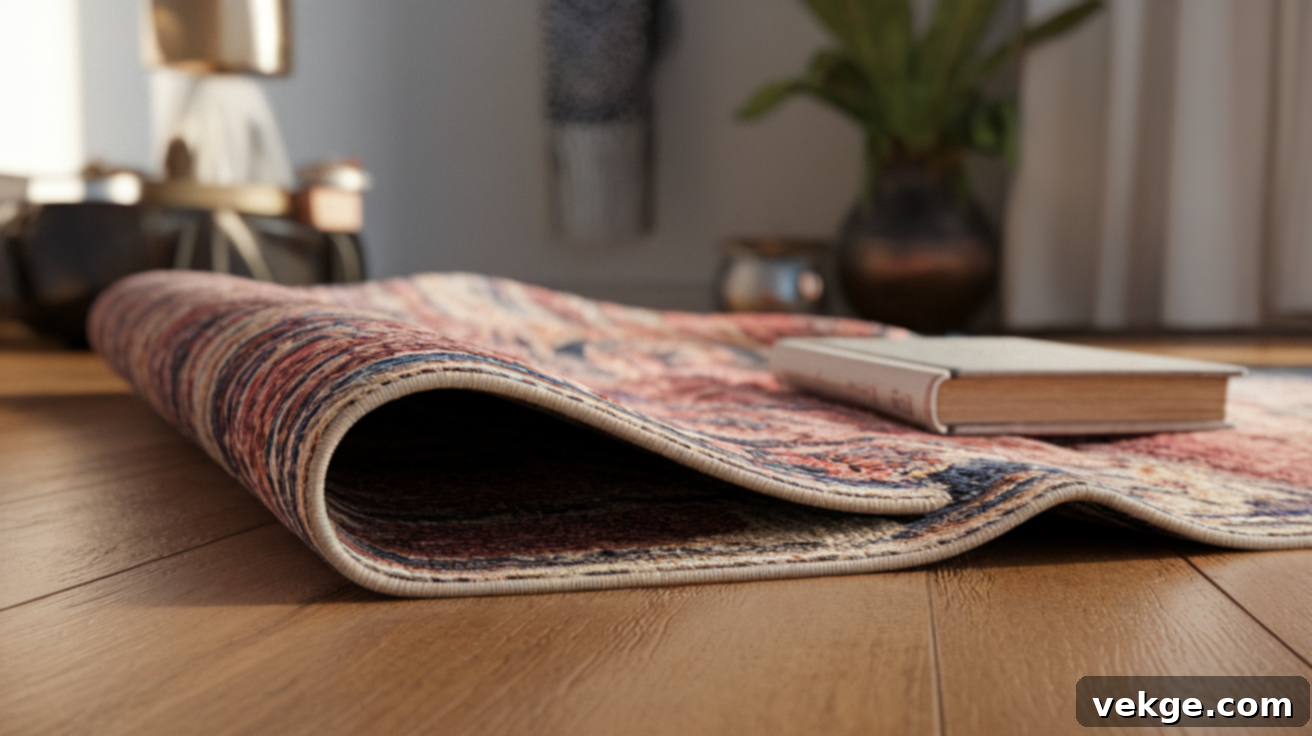
When you’re looking for a quick, temporary fix for a single, persistent popped-up corner, the temporary corner folding method can provide immediate relief. If one corner consistently curls upwards, gently fold that edge underneath itself. Essentially, you’re bending the corner in the exact opposite direction of its curl. Hold it in this folded position, or place a light weight on it, for a few hours. Then, carefully unfold it and check if it lies flatter. You can repeat this process as many times as needed until the corner yields. This method applies a localized, opposing force to the curl, helping the fibers to relax. However, it’s crucial to proceed with caution. Not all rugs are equally pliable. If your rug is made of a very stiff material, has a rigid backing, or is easily damaged, this method might leave a permanent crease or even crack the backing. Always assess your rug’s material and flexibility before attempting this technique.
Material-Specific Rug Flattening Strategies
The material composition of your rug significantly dictates which flattening methods will be most effective and, more importantly, which ones to avoid. Understanding your rug’s fibers is key to preventing damage while achieving a perfectly flat surface. Here’s a closer look at common rug types and their ideal flattening approaches:
Wool Rugs: Renowned for their softness and durability, wool rugs are natural fibers that can be sensitive to excessive moisture and heat. They tend to have good ‘memory’ for their rolled shape. Gentle, consistent pressure and dry methods work best.
Synthetic Rugs (Polypropylene, Polyester, Nylon): These man-made fibers are generally more robust and versatile. They respond well to gentle heat and moisture, making them easier to manipulate back into shape.
Natural Fiber Rugs (Jute, Sisal, Seagrass, Cotton): These materials offer a rustic charm but can be very sensitive to moisture, which can cause shrinking, discoloration, or mold. Dry methods and gentle handling are paramount.
Rubber or Latex Backed Rugs: Often found in entryways or kitchens, these backings provide grip but can develop very stubborn curls due to their rigidity. Heat and sun can degrade these backings.
| Rug Type | Use This | Avoid This |
|---|---|---|
| Wool | Reverse roll, rug pad, steady weight (books, furniture), natural relaxation | Steam, excessive wet towels, intense direct sunlight, high heat |
| Synthetic (Polypropylene, Polyester, Nylon) | Low heat (hair dryer, steam iron over damp towel), ice cube method, rug tape, reverse roll, rug pad, steady weight | High heat, prolonged direct hot iron contact, harsh chemicals |
| Natural Fiber (Jute, Sisal, Cotton) | Reverse roll, rug pad, steady weight, natural relaxation | Any excessive moisture, steam, ice cube method, direct strong heat, harsh cleaning agents |
| Rubber or Latex Backed | Rug tape/grippers, light steady pressure, reverse roll (gentle), natural relaxation | High heat, prolonged direct sun exposure, direct ironing, strong solvents |
Common Pitfalls to Avoid When Flattening Your Rug
While flattening your new rug is generally a straightforward process, it’s crucial to be aware of potential mistakes that could lead to damage or an ineffective outcome. Avoiding these common pitfalls will help preserve your rug’s beauty and longevity:
- Using Too Much Heat: Applying excessive heat, whether from a steam cleaner, a hot iron directly on the fibers, or prolonged exposure to intense sunlight, can severely damage your rug. High temperatures can cause synthetic fibers to melt, warp, or become brittle, while natural fibers like wool can shrink, felt, or discolor irreversibly. Always use the lowest effective heat setting, keep tools moving, and always place a protective damp cloth between the heat source and the rug.
- Leaving Rugs Damp: While some methods involve a bit of moisture (like the ice cube method or damp towel with heat), it’s imperative to ensure your rug is thoroughly dry afterward. Leaving a rug damp, even for a short period, creates an ideal breeding ground for mold and mildew. This can lead to unpleasant odors, discoloration, deterioration of fibers, and potential health issues. Always air-dry your rug completely in a well-ventilated area before placing it back down or storing it.
- Forcing Rug Fibers Unnaturally: Attempting to aggressively pull, stretch, or forcefully bend stubborn creases can lead to permanent damage. This includes tearing the backing, breaking individual fibers, or creating new, irreversible folds. Rugs need gentle persuasion rather than brute force. Use consistent, gentle pressure and allow the rug to settle naturally over time with the help of the methods described.
- Using Harsh Chemicals or Abrasive Tools: While not directly related to flattening, some people might be tempted to use strong cleaning agents or abrasive brushes to “soften” stubborn areas. This can strip the rug of its natural oils, damage dyes, or even tear the fibers. Always stick to gentle methods and products specifically designed for rugs.
- Not Testing Methods in an Inconspicuous Area: Before applying any method, especially those involving heat, moisture, or adhesive, always perform a small test in a hidden area of the rug (e.g., underneath a corner or in a spot that will be covered by furniture). This allows you to check for colorfastness, material reaction, and potential damage without risking the rug’s visible surface.
Conclusion
Congratulations! You now possess a comprehensive toolkit and the knowledge to confidently flatten a new rug, eliminating those frustrating curls, bumps, and wrinkles. Whether your rug needs the gentle persuasion of reverse rolling, the steadfast pressure of everyday weights, the relaxing warmth of gentle heat, or the foundational support of a quality rug pad, you have multiple proven strategies at your disposal. Each method offers a unique approach to tackle different types of rug memory, ensuring your new acquisition settles perfectly into its designated space.
Remember, the golden rule in rug flattening is patience. While some methods offer quicker results, allowing your rug ample time to acclimate and relax will always yield the best, most lasting outcome. Give it the time and attention it needs, and you’ll soon enjoy a smooth, beautiful rug that enhances your home’s aesthetic and provides a safe, comfortable surface for years to come. We hope these detailed tips and tricks make the process easier and more enjoyable for you.
If you’re seeking more expert advice, helpful guides, or creative inspiration for maintaining and beautifying your living spaces, don’t hesitate to explore our other blogs. Let’s continue working together to make your home both functional and flawlessly stunning!
